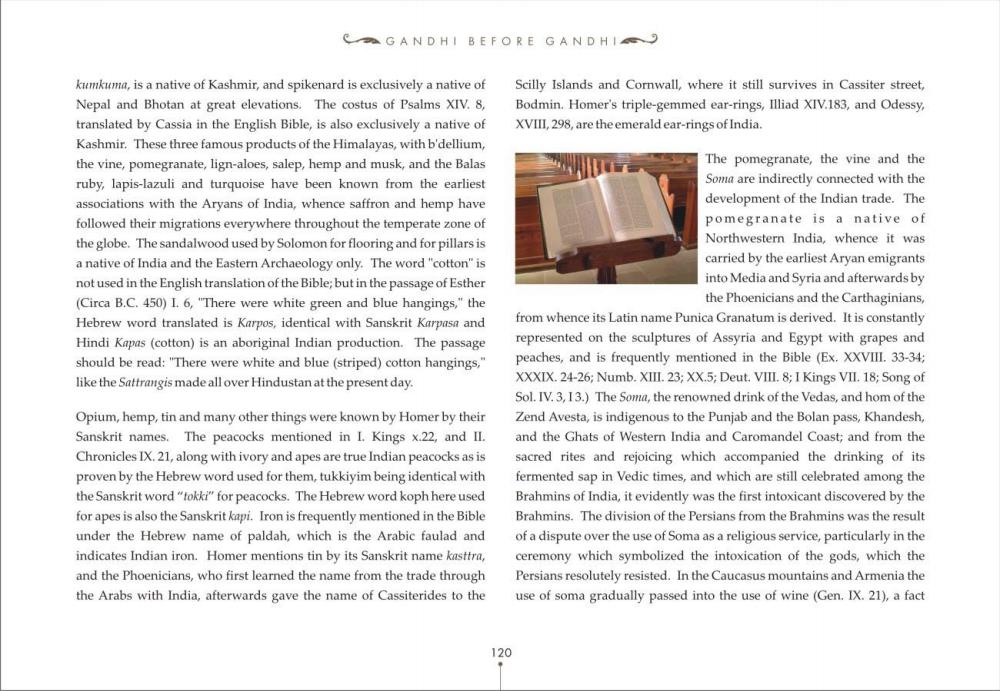________________
GANDHI BEFORE GANDHI
Scilly Islands and Cornwall, where it still survives in Cassiter street, Bodmin. Homer's triple-gemmed ear-rings, Iliad XIV.183, and Odessy, XVIII, 298, are the emerald ear-rings of India.
kumkuma, is a native of Kashmir, and spikenard is exclusively a native of Nepal and Bhotan at great elevations. The costus of Psalms XIV. 8, translated by Cassia in the English Bible, is also exclusively a native of Kashmir. These three famous products of the Himalayas, with b'dellium, the vine, pomegranate, lign-aloes, salep, hemp and musk, and the Balas ruby, lapis-lazuli and turquoise have been known from the earliest associations with the Aryans of India, whence saffron and hemp have followed their migrations everywhere throughout the temperate zone of the globe. The sandalwood used by Solomon for flooring and for pillars is a native of India and the Eastern Archaeology only. The word "cotton" is not used in the English translation of the Bible; but in the passage of Esther (Circa B.C. 450) 1. 6, "There were white green and blue hangings," the Hebrew word translated is Karpos, identical with Sanskrit Karpasa and Hindi kapas (cotton) is an aboriginal Indian production. The passage should be read: "There were white and blue (striped) cotton hangings," like the Sattrangis made all over Hindustan at the present day.
The pomegranate, the vine and the Soma are indirectly connected with the development of the Indian trade. The pomegranate is a native of Northwestern India, whence it was carried by the earliest Aryan emigrants into Media and Syria and afterwards by
the Phoenicians and the Carthaginians, from whence its Latin name Punica Granatum is derived. It is constantly represented on the sculptures of Assyria and Egypt with grapes and peaches, and is frequently mentioned in the Bible (Ex. XXVIII. 33-34; XXXIX. 24-26; Numb. XIII. 23; XX.5; Deut. VIII. 8; 1 Kings VII. 18; Song of Sol. IV. 3, 13.) The Soma, the renowned drink of the Vedas, and hom of the Zend Avesta, is indigenous to the Punjab and the Bolan pass, Khandesh, and the Ghats of Western India and Caromandel Coast; and from the sacred rites and rejoicing which accompanied the drinking of its fermented sap in Vedic times, and which are still celebrated among the Brahmins of India, it evidently was the first intoxicant discovered by the Brahmins. The division of the Persians from the Brahmins was the result of a dispute over the use of Soma as a religious service, particularly in the ceremony which symbolized the intoxication of the gods, which the Persians resolutely resisted. In the Caucasus mountains and Armenia the use of soma gradually passed into the use of wine (Gen. IX. 21), a fact
Opium, hemp, tin and many other things were known by Homer by their Sanskrit names. The peacocks mentioned in I. Kings x.22, and II. Chronicles IX. 21, along with ivory and apes are true Indian peacocks as is proven by the Hebrew word used for them, tukkiyim being identical with the Sanskrit word "tokki" for peacocks. The Hebrew word koph here used for apes is also the Sanskrit kapi. Iron is frequently mentioned in the Bible under the Hebrew name of paldah, which is the Arabic faulad and indicates Indian iron. Homer mentions tin by its Sanskrit name kasttra, and the Phoenicians, who first learned the name from the trade through the Arabs with India, afterwards gave the name of Cassiterides to the
120




